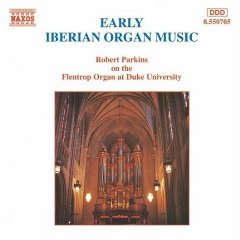Early Iberian Organ Music (1994)
Early Iberian Organ Music (1994)

01. Anonymous - Entrada [3:39] 02. Antonio de Cabezon - Tiento I [4:25] 03. Antonio de Cabezon - Diferencias on the Italian Pavane [3:25] 04. Antonio de Cabezon - Diferencias on the Milanese Galliard [2:58] 05. Antonio de Cabezon - Tiento on Qui la dira [3:40] 06. Antonio Carreira - Fantasia on the 1st tone [2:00] 07. Bernardo Clavijo del Castillo - Tiento on the 2nd tone [5:01] 08. Francisco de Peraza - Medio registro alto [3:19] 09. Sebastian Aguilera de Heredia - Tiento de falsas on the 4th tone [4:49] 10. Manuel Rodriguez Coelho - Tiento on the 4th tone [5:28] 11. Francisco Correa de Arauxo - Tiento de medio registro de baxon [4:06] 12. Pablo Bruna -Tiento on the Litany of the Virgin [7:11] 13. Juan Cabanilles - Pasacalles I [3:15] 14. Juan Cabanilles - Xacara [5:06] 15. Anonymous - Variations on the Gayta [3:21] Robert Parkins - organ
The most striking visual feature of organs in Spain and Portugal is undoubtedly the array of horizontal reed pipes cantilevered from the façade of the main case. Yet, this peculiar invention did not arrive until the last third of the 17th century, well toward the end of the great age of early Iberian organ music (c1550-c1700). The instruments for which the bulk of the literature was written were indeed distinctive but less flamboyant, most possessing only one or two manual keyboards and rudimentary pedals (or none at all).
The anonymous Entrada, taken from manuscripts compiled by Antonio Martin y Coll after the turn of the 18th century, specifically calls for the brilliant horizontal trumpets (clarines). The canciones that follow feature echoes as well, exploiting devices that began to appear in Spanish organs not long after the introduction of horizontal reeds.
The history of early Iberian keyboard music is to some extent the history of the tiento (Port. tento), already well developed by the mid-16th century. Many early tientos resembled keyboard transcriptions of polyphonic motets of the period, for the imitative contrapuntal fabric woven around several themes translated easily to the organ.
Antonio de Cabezón's Tiento I is far more idiomatic and sophisticated than these, but his Tiento on Oui la dira (based on a chanson) retains the simpler vocal style. Undoubtedly the most inspired genius of pre-18th-century Iberian organ music, the blind Cabezón was no less a master of the variation form. The practice of devising keyboard variations (diferencias) on popular tunes had already been cultivated to a surprisingly high level in 16th-century Spain, earlier than in other European countries. Cabezón's diferencias on the Italian Pavane and the Milanese Galliard are continuous variation sets on two common dances of the time.
António Carreira, Cabezón's Portuguese contemporary, provided no title for his piece referred to here as Fantasia on the 1st tone. It is an uncomplicated but effective work in the usual imitative style and could just as easily have been labeled tento.
The Tiento on the 2nd tone is the only surviving work by the Spaniard Bernardo Clavijo dei Castillo. Its serene style suggests that it is a forerunner of the tiento de falsas, a subgenre to become common in 17th-century Spain.
During the last third of the 16th century, a remarkable innovation took place that would alter the character of the Iberian organ forever. Builders began to splitone or more stops between the bass and treble halves, allowing for two different registrations on the same keyboard. Peraza's Medio registro alto, designating a divided registration with the solo in the top line and an accompanying sound for the lower voices, is probably the earliest surviving tiento to specify this technique.
Sebastian Aguilera de Heredia was the seminal figure of the Aragonese school, centered around Saragossa. Several of his 18 extant works are prototypes for a number of genres to flourish in 17th-century Spain. His second Tiento de falsas on the 4th tone was among the first to use the term falsas, the slow-moving dissonant suspended notes that characterize this meditative "vocal" style.
During the entire 17th century, only two collections of keyboard music were actually published in Iberia. The first of these was the Flores de musica (1620) by the Portuguese master Manuel Rodrigues Coelho. He included three tientos in each mode, and the first Tiento on the 4th tone is one of the most engaging. The four themes are all at least tenuously related.
Francisco Correa de Arauxo's Facultad organica was printed just a few years later in 1626. Correa included many tientos for divided stops in this volume, and the Tiento de medio registro de baxón calls for a solo in the bass (baxón). The most fascinating aspect of this particular piece is the section in septuple meter (7/ 8) near the end.
Pablo Bruna, blind like the venerable Cabezón, was a later disciple of the Aragonese school. His Tiento on the Litany of the Virgin is in reality a loose string of variations intended to be played on divided registers (although not indicated in the title).
The last great composer from the "golden age" of early Iberian organ music was Juan Cabanilles. His prolific output includes virtually every genre in this literature, including variations...a compositional technique that had dwindled in popularity after the era of Cabezón. Pasacalles I, the first of five, is a simple set of 18 continuous variations on a four-measure harmonic scheme. The virtuosic Xácara is more complex and less restrained, based largely on a repeated pattern from a vulgar street dance.
The anonymous Variations on the Gayta, like the opening Entrada, is taken from the Martin y Coll collection. The word gayta means "bagpipe", an instrument especially popular in the Spanish region of Galicia. This enchanting little piece serves as a reminder that not all Iberian organ music from this period is austere or even serious. ---Robert Parkins, naxos.com
download (mp3 @320 kbs):
uploaded yandex 4shared mega mediafire solidfiles zalivalka cloudmailru oboom








